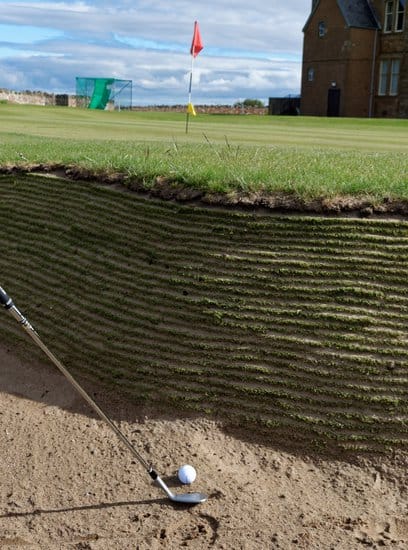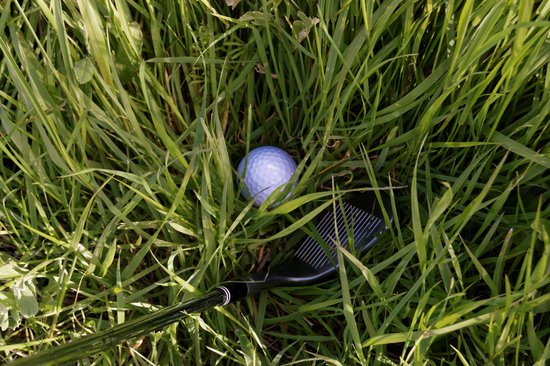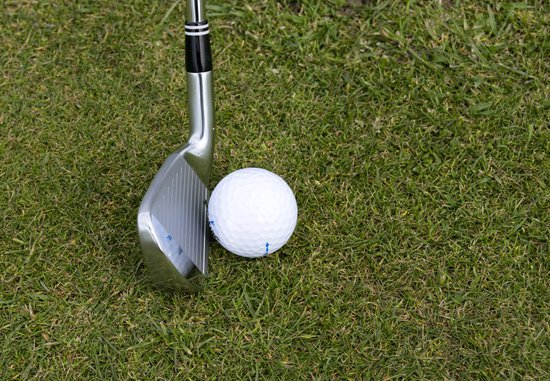If you have ever watched a golf tournament you likely have heard an announcer or player say the phrase “up and down”. This phrase could be referring to quite a few different situations in golf, but they all are essentially the same thing. What is an up and down in golf?
An up and down in golf is when a golfer takes one shot to get the ball up onto the green and then the next putt to make it down into the hole.
Golfers will often express how important it is for them to get up and down to save strokes and to keep momentum going in a round. Let’s discuss all the different scenarios for up and down’s and the challenges that each type of scenario presents.
What is an Up and Down in Golf?
As we just discussed, an up and down in golf is when a golfer takes one shot to get the ball up onto the green and then the next putt to make it down into the hole. An up and down in golf is a two shot sequence that results in a made putt.
There are several different locations on a golf course where an up and down may apply. Some of the most important include:
- Getting Up and Down from a Bunker
- Getting Up and Down from the Rough
- Getting Up and Down from the Fairway
Let’s take a closer look at specific examples of getting up and down in golf.
Getting Up and Down from a Bunker
An up and down in golf can come into play many time from a green-side bunker. Bunkers are meant to make a golf course play harder and provide a greater challenge to golfers.
Bunkers are considered a hazard in golf and so there are specific rules that golfers must abide by while playing out of a bunker that don’t apply in other situations.
Golfers are not allowed to build a stance, which is moving sand around to allow them to get in a better position to hit the golf ball. Golfers also can’t ground their club, which is simply touching the sand in any way with their club prior to hitting the golf ball.
Another challenge with playing out of a bunker is the ball can be plugged or partially plugged in the sand. Plugged is when the golf ball is completely under or almost completely under the sand. This makes it extremely difficult to get the ball to come out of the sand with any predictability.
The positioning of a golf ball in a bunker also plays a huge role whether or not an up and down is realistic. Some bunkers have tall side walls that make it very difficult on golfers. Some side walls like this can be a significant challenge:

Getting the ball up and out of the bunker and onto the green is something professionals are very good at despite how difficult it can be. If professionals have a non-plugged lie in the bunker, they often get the ball to finish within 6 feet of the hole.
Getting Up and Down from The Rough
Getting up and down from the rough in golf can also be very important near the green. Unlike playing from a bunker, playing from the rough doesn’t have any additional rules that a golfer must be aware of.
That said, there are two major challenges that face a golfer who is trying to hit the ball close to the hole from out of the rough. Those two major factors are:
- How the golf ball is lying in the grass.
- What type of grass they are playing from.
How the Golf Ball Is Lying in The Rough
The lie of a golf ball is probably the most significant part of playing from the rough, and therefore greatly impacts the ability of a golfer to get the ball up and down in golf. When a ball is nestled down to the bottom of the grass and is barely visible, that is known as a ‘buried lie’.
This means that the ball has come to rest and has worked its way all the way to the ground. This would be an example of a buried lie:

It is very difficult to make clean contact with the ball in these types of lies. As you can see in the photo, grass ends up being between the ball and the clubface. This is a problem because having grass between the clubface and the golf ball at impact will not allow a golfer to get any backspin on the ball. Being able to put backspin on the ball is key because it will allow a golfer to stop the ball faster and control how far it will go.
Compare a lie in thick rough to a ball in the fairway like this one below. The clubface has a clear path to the ball and the golfer will be able to control the spin much easier.

Even if the ball is in the rough, if it is lying at the top of the grass, this is referred to as a ‘clean lie’. This means that the golfer will be able to easily hit the ball without any grass in between the clubface and the golf ball, which will allow the golfer to be able to control how far the ball goes much easier.
The Effect of Grass When Playing from The Rough
Golf courses around the world use different types of grass to present different types of challenges. Each golf course will have an entire staff whose main focus will be to upkeep and nourish the grass on the golf course.
The type of grass on a golf course will affect the way a golfer chooses to play the course. There are certain types of grass that are extremely thick and tall. The challenge from thick and tall grass is the ball will nestle all the way down to the ground and often be a buried lie in the rough.
There are other types of grass that will grow thick but not as tall, so the ball will sit up on top of the grass. The challenge with these types of grasses is they often cause mis-hits because the club will easily be moved off line if you hit the grass before hitting the ball (due to how thick the grass is). So the types of grass can affect the chances of getting up and down in golf.
There are many other types of grasses that each vary in their combination of thickness and height. Each grass presents its own set of challenges and the golfer will need to be aware of what type of grass they are playing from.
Getting Up and Down from A Water Hazard
Getting up and down in golf from a water hazard is very rare. The vast majority of the time when someone hits their ball into the water, they have to take a drop and then play from there. The big misconception is that you can’t play from the water hazard. This is not true.
Golfers are allowed to play their ball from a water hazard if they wish to. The rules are similar to playing from a bunker in that a golfer can’t ground their club before they swing to hit the ball.
When a ball is barely sitting in the water and a golfer can swing and hit the ball, they can play the shot. There have been some really famous shots by professional golfers hitting their ball out of water hazards. The most famous up and down out of the water is when Bill Haas did it in the final round of the 2011 Tour Championship (view).
Getting Up and Down from The Fringe
Getting up and down from the fringe is quite easy, and is expected from pro golfers. The fringe is a small section of grass between the green side rough and the green itself. The grass height that makes up the fringe is always taller than the green but shorter than the rough.
The fringe is basically an extension of the green and doesn’t present much of a challenge to getting up and down, except in one situation: sometimes the golf ball ends up against the collar. The collar is the area where the fringe turns into the rough.
Since the rough is taller than the fringe, the golfer won’t be able to hit the golf ball without having grass between the club and the ball. As noted before, grass between the club and the ball always presents more difficulty for a golfer trying to get up and down.
Getting Up and Down from The Fairway
When golfers talk about up and downs, they usually aren’t referring to playing from the fairway. Though there are plenty of times where getting up and down from the fairway is needed.
Usually there is fairway right up to the fringe of the green, so there are many times the ball is still in the fairway after the golfer’s approach shot. Getting up and down from the fairway is the second easiest area to get up and down from. Only getting up and down from the fringe is easier.
The one challenge getting up and down from the fairway presents is usually the grass in the fairway is cut very low and the grass is very lush which means it grows together very tightly. This is known as having a tight lie.
When you have a tight lie and are hitting the ball short distances, it is easy to have the club hit the ground first which will cause the ball to not go as far as intended. This is known as chunking the golf shot.
Getting Up and Down from Sandy Areas
Sandy areas are similar to bunkers but there are some notable differences. Sandy areas are not hazards and don’t have any of the hazard rule restrictions. Even though these areas are sand areas they usually only have a thin layer of sand on top of dirt.
Golf courses will distinguish these areas to the players in their local rule books. These types of areas are becoming more popular because they keep the golf course challenging and still looking nice while reducing irrigation costs since they don’t have to be watered.
Because these areas only have a small amount of sand, they play much different that bunkers do. The biggest challenge with these types of shots is hitting the ball perfectly in the middle of the clubface. The lies in these sandy areas will usually be buried just slightly in the sand, which can cause a golfer to hit too much of the sand and the ball will not go as far as intended.
Since the ground is also hard right underneath of the sand, golfers can also misjudge how much bounce the club will have when the club hits the ground. Bounce is how much the club recoils up off of the ground after making contact with the ground.
If the club bounces up too much, the golfer will hit what is known as a thin shot. This means they hit the golf ball with the bottom part of the club. The result from a thin shot is a very low trajectory shot that flies the intended distance but rolls out and keeps going for a long distance after it hits the ground, due to its low trajectory.
Hitting a thin shot and having it roll out far past the hole (and possibly off the green) makes it almost impossible for the golfer to go up and down.
Getting Up and Down from Wooded Areas
Getting up and down in golf from a wooded area can be difficult, because wooded areas present a completely different challenge than any other area. As you would imagine, these are areas surrounded by trees and other forestry.
Usually there isn’t much grass in these areas, but there are many things that can still impede the lie such as twigs, leaves, and tree roots. When golfers make the mistake of hitting their golf ball into wooded areas, they are hoping they get lucky and get a good lie.
The biggest issue though is trying to hit the ball around and out through the trees. Professional golfers are really good at being able to hit the ball and making it curve the way they want it to, but they can only do so much.
Getting Up and Down from Pine Straw
Getting the ball up and down in golf from pine straw is similar to hitting out wood mulch. The lie of the golf ball is always impeded in some way as the surface is never even. The biggest issue for a golfer hitting out of pine straw is footing.
Standing in pine straw and trying to swing a club while keeping your feet from slipping is very hard to do. A golfer’s feet may slip when they are on their downswing which can cause any number of mishits and the golf ball to go just about anywhere. If the golfer is able to keep their feet from slipping, then the shot usually isn’t that difficult.
